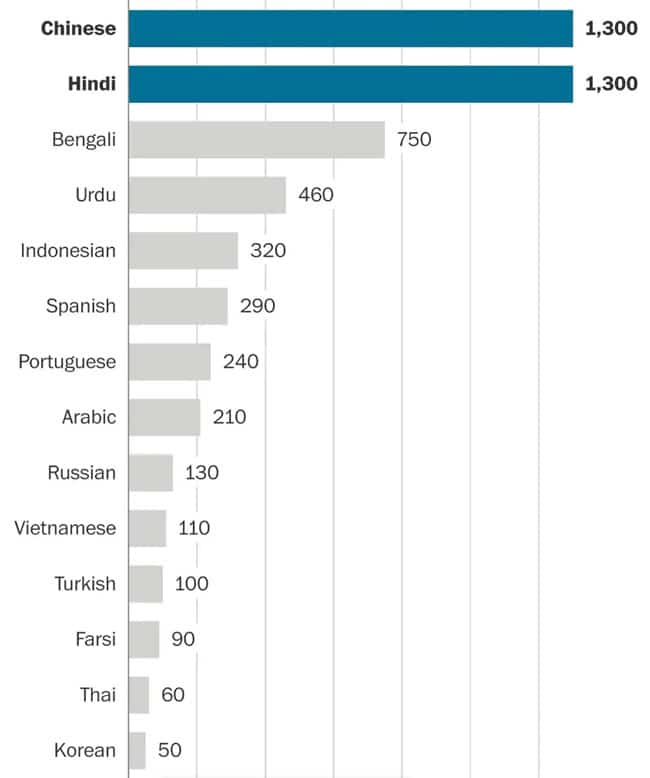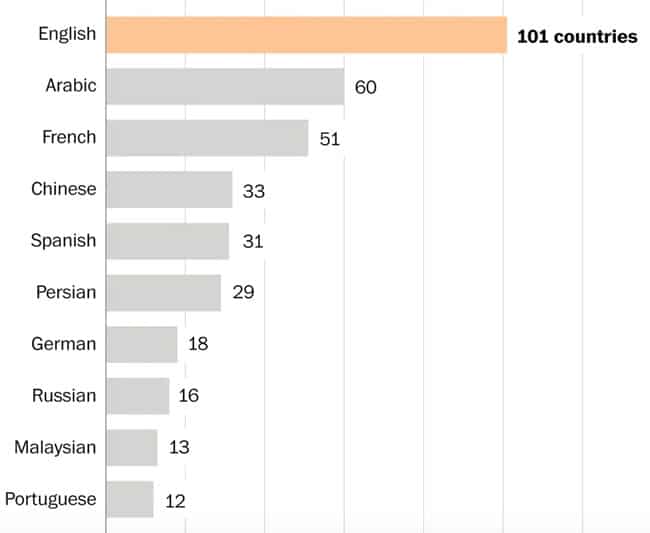The world’s changing language landscape
It used to be – and not that very long ago – that the list of most important languages in the world to know would have been quite small. French, English, Spanish, and German would have made the list, plus a handful of others depending on where in Europe and Asia one lived. Accordingly, these were the languages most in demand by students across the world looking to extend their linguistic repertoire beyond their mother tongue either for career or cultural/personal reasons.
But of course, the landscape of global power and business has changed dramatically, with the past decade characterised by the striking ascent of China (and the growing importance of other BRICS countries: Brazil, Russia, India, and South Africa) and the surging youth populations in Africa (e.g., one in four people aged 15–24 will live in the continent by 2030, according to the United Nations) and the Middle East (where the population is expected to double to over 1 billion inhabitants by 2100).
English remains, by far, the world’s most studied language. But these factors have, to say the least, extended the consideration sets of many prospective language learners across the world – and thus increased the range of opportunities for language providers in a growing list of countries.
Arabic and Chinese make the top five
There are any number of ways to imagine how demand for certain languages will change over the next decade, not the least of which is guidance for national policy from respected, established international education bodies such as the British Council. The organisation recently released a report entitled Languages for the Future, which ranked the top 10 most important languages for the UK going forward according to the following determining factors:
- Current UK export trade
- Language needs of UK business
- UK government trade priorities
- Emerging high growth markets
- Diplomatic and security priorities
- The public’s language interests
- Outward visitor destinations
- UK government’s International Education Strategy priorities
- Levels of English proficiency in other countries
- The prevalence of different languages on the internet
On the basis of those factors, the British Council arrived at this top 10 list of priority languages for Britons:
- Spanish
- Arabic
- French
- Mandarin Chinese
- German
- Portuguese
- Italian
- Russian
- Turkish
- Japanese
Knowing Spanish will be increasingly advantageous for anyone doing business with the United States, not to mention Latin American countries: some experts predict that the US will be home to the largest Spanish speaking population by 2050. This is one reason that Spain remains one of the most popular destinations for language study in the world.
German-language studies also remain popular, with one study finding that while German is ranked #10 globally in terms of native speakers, the language is ranked fourth – after only English, French, and Mandarin, in terms of non-native speakers who have learnt the language.
Asian languages on the rise
The United Nations, meanwhile, charts key languages according to demographic predictions for 2050. According to this chart, knowing at least one South or Southeast Asian language would be an advantage for many students as many Asian economies are strengthening at the same time as their populations expand.
The Washington Post remarks, “Hindi, Bengali, Urdu and Indonesian will dominate much of the business world by 2050, followed by Spanish, Portuguese, Arabic and Russian. If you want to get the most money out of your language course, studying one of the languages listed above is probably a safe bet.”

Don’t forget about French
All of these increasingly important languages do not take away from the fact that French remains an official language in many countries, and that whatever romantic and nostalgic associations any of us may have should be well-tempered with a striking fact: French is a fast-growing language. Forbes Magazine reports that,
“[French] is growing in the fastest-growing areas of the world, particularly sub-Saharan Africa. The latest projection is that French will be spoken by 750 million people by 2050.”
Forbes also notes that despite the urgency some now feel to learn Mandarin Chinese given China’s rise over the past decade, there are factors that may dampen demand for the language going forward:
“The other mooted language of the future, Mandarin, despite being excruciatingly hard to learn for most Westerners, will probably not be that given China's certain demographic slide. Meanwhile, French will be present on all continents, and particularly predominant in a continent that, by 2050, should be a fast-growing economic powerhouse–Africa.”
Language concentrations across the globe
The following chart from the Washington Post shows that English, Arabic, and French are the languages spoken in the greatest number of countries.

Digital movers
Demand for (and revenue generated by) language learning is now split between digital learning platforms or apps and schools. In May 2018, the global digital market for language learning was valued at US$3.25 billion and is expected to grow to US$11.45 billion by 2027.
In March 2019, market research firm The Insight Partners released a report attributing the increasing share of digital to “increasing adoption of the digital education system, implementation of advanced level English curriculum in schools, increasing number of immigrants for higher education.” They note that “the Asia-Pacific region is anticipated to provide numerous profitable opportunities [for digital language companies] … in the coming years.”
Trends in English-language learning
As long as the new list of popular languages to learn may now be, there’s something that has remained constant for decades: English remains the world’s lingua franca, and the British Council estimates that there are now 1.5 billion English-language learners worldwide.
Here are the trends from the world’s leading destinations for English language study over the past couple of years:
- The Australian sector was essentially flat in 2018, both in terms of student weeks and numbers.
- Enrolment in Canadian language schools grew by 6% in 2018.
- Enrolments in US Intensive English Programmes fell by 10% in 2018, and student weeks fell by 13.7%.
- There was modest growth in British ELT in 2018, but results were uneven across the public and private sectors.
- In Ireland, enrolments fell by nearly 5% in 2018 but student weeks grew by 5%.
- In Malta, enrolments were flat in 2018 while student weeks fell by 11.9%.
- In South Africa, student numbers fell by 5% but student weeks grew by 5%.
Education agents’ view
In 2016, the International Association of Language Centres (IALC) released a report based on research from 60 secondary sources, 466 responding agents representing 74 different countries, as well as 21 in-depth interviews with agents. In terms of the motivations for studying a particular language, the IALC report found that:
- German and English were primarily popular as a basis for current and future studies;
- Portuguese and Italian were popular for personal reasons (e.g., personal interest, interest in these cultures);
- Demand for French was motivated by a balanced mix of reasons (i.e., motivated by personal, employment, education-related needs);
- Russian and Chinese courses were taken mostly with a goal of improving employment prospects.
For additional background, please see:
















